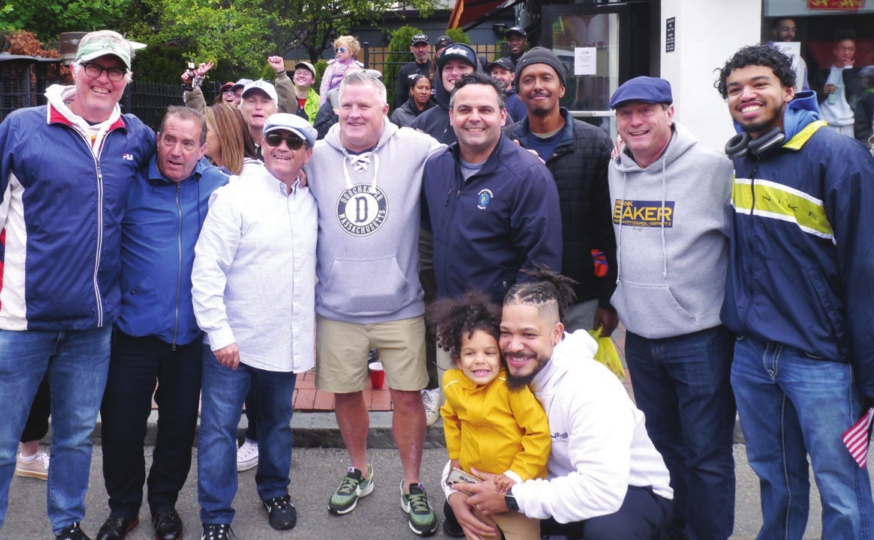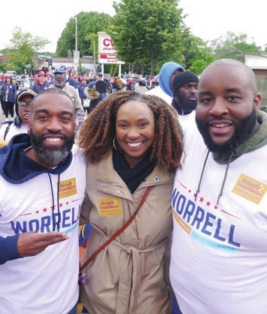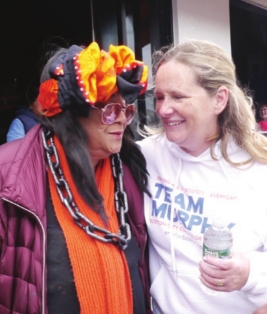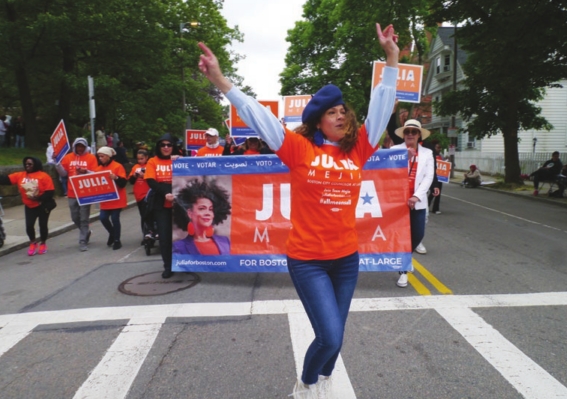
(Clockwise from top left): District 3 Councilor Frank Baker (3rd from
left) and state Sen. Nick Collins (4th from right) enjoy a moment with
supporters outside the Blarney Stone in Fields Corner.

City Councilor
Brian Worrell and state Reps. Brandy Fluker Oakley and Chris Worrell
(right) prepare to march in Lower Mills.

At-large Councilor Erin Murphy
greets supporters in Fields Corner.

At-large Councilor Julia Mejia leads
her group of supporters.
Frank Baker won’t be appearing on the ballot this year. After 10 years in office, the District 3 City Councilor from eastern Dorchester is calling it quits.
But you wouldn’t know it by his presence in last Sunday’s Dorchester Day Parade, where he practically jogged the three-mile route, zig-zagging from one side of the street to the other, shaking hands. Why?
“These are my people,” said Baker, who marched with state Sen. Nick Collins, his own brothers James and Vincent, and a contingent of supporters. “I never miss Dorchester Day. It’s a tradition that started in 1904. It’s part of us.”
The parade commemorates the June 1630 founding of Dorchester as a Puritan community in Massachusetts Bay Colony. In the current era, the parade also stands as one of the year’s most significant campaign events, often drawing candidates for both local and statewide offices.
The size of a candidate’s contingent in the parade and the energy with which she or he greets spectators on the parade route sometimes gives an early indication of campaign viability.
On Sunday, the field of contenders for the District 3 seat Baker is vacating at the end of the year made low-key appearances, collecting signatures along Dorchester Avenue but not marching in the parade. Schoolteacher Joel Richards and political activist Barry Lawton were on hand, as was Ann Walsh, whose campaign launch was delayed by the twists and turns in the Council’s recent redistricting process.
“Two weeks ago, I lived in District 4,” said Walsh, a Butler Street resident. “There’s a little confusion right now. We’re helping people figure out what side they’re on.”
In the at-large Council race, incumbents Julia Mejia, Ruthzee Louijeune and Erin Murphy made appearances, marching with large contingents.
Mejia, who was sandwiched between the anti-displacement Dot Not for Sale group and the high-intensity dance beats of the Estrellas Tropicales (Tropical Stars) dance group, brought three dozen supporters — more than any other candidate — and a heavy dose of campaign-trail energy as she greeted spectators on the parade route.
“I may not have the money, but I have the people,” said Mejia, whose campaign fund balance of $28,000 lags behind those of her at-large colleagues — Michael Flaherty with $222,000; Louijeune with $105,000; and Murphy with $76,000.
In addition to bodies, Mejia boasts a Dorchester-specific brand of street cred.
“This parade means a lot to me,” she said. “I was Miss Dorchester in 1989.”
While that position entitled the teenage Mejia a place of honor in the parade, it didn’t come easy.
“I only won because I sold more M&Ms than anyone else,” said Mejia, who graduated from Dorchester High.
Other Dorchester elected officials who appeared in this year’s parade included brothers Brian and Christopher Worrell, the councilor from District 4 and state representative from the 5th Suffolk district, respectively. They marched with Rep. Brandy Fluker Oakley from the 12th Suffolk district.
Why does it matter?
Candidates pay $400 to march in the Dorchester Day parade, which takes them from the southern end of the neighborhood to within a few blocks of its border with South Boston.
Spectators and participants in the parade represent a wide range of the neighborhood’s population of 120,000, which includes pockets of Irish American, Vietnamese, African American, Caribbean American and Latino residents.
“The parade represents the diversity of Dorchester, from Lower Mills to Columbia Road,” said Louijeune, who marched with her supporters and sprinted from one side of Dorchester Avenue to the other to greet spectators.
According to political wisdom, Louijeune was doing what a candidate is supposed to do in the Dorchester Day parade.
“The political objective is always to meet people,” said Linda Dorcena Forry, who represented Dorchester as a state representative and state senator and views the parade with her family near the St. Gregory Parish in Lower Mills.
“Folks don’t understand the importance of face-to-face contact. A lot of people want to rely on Facebook or Instagram,” Dorcena Forry said. “You want people to feel that they’ve connected to you so they can see that you’re approachable.”
The elected officials present Sunday seemed to get the assignment. At the head of the parade, Mayor Michelle Wu, who won’t appear on the ballot again until 2025, said she was using the event as an opportunity to listen to constituents air their concerns — students who want newspapers in every BPS school, long-time residents struggling with the cost of housing, opponents of a proposed 72-unit housing development on Centre Street, as well as supporters of the same project.
“I hear a lot about housing,” Wu said. “One neighborhood resident told me she received an eviction notice from her landlord. She wants to stay in Dorchester. You hear that story far too often.”
As mayor, Wu is expected to march in all the city’s parades, from the Caribbean Carnival in Roxbury to the Columbus Day Parade in the North End — a tremendous investment of shoe leather and stamina. The same is expected of the city’s four at-large councilors. How do they maintain their smiles and enthusiasm through miles of marching?
“I feed off of people’s energy,” said Mejia, while dancing to the music blasting from the Estrellas Tropicales truck, just behind her contingent. “I thrive on being in community.”